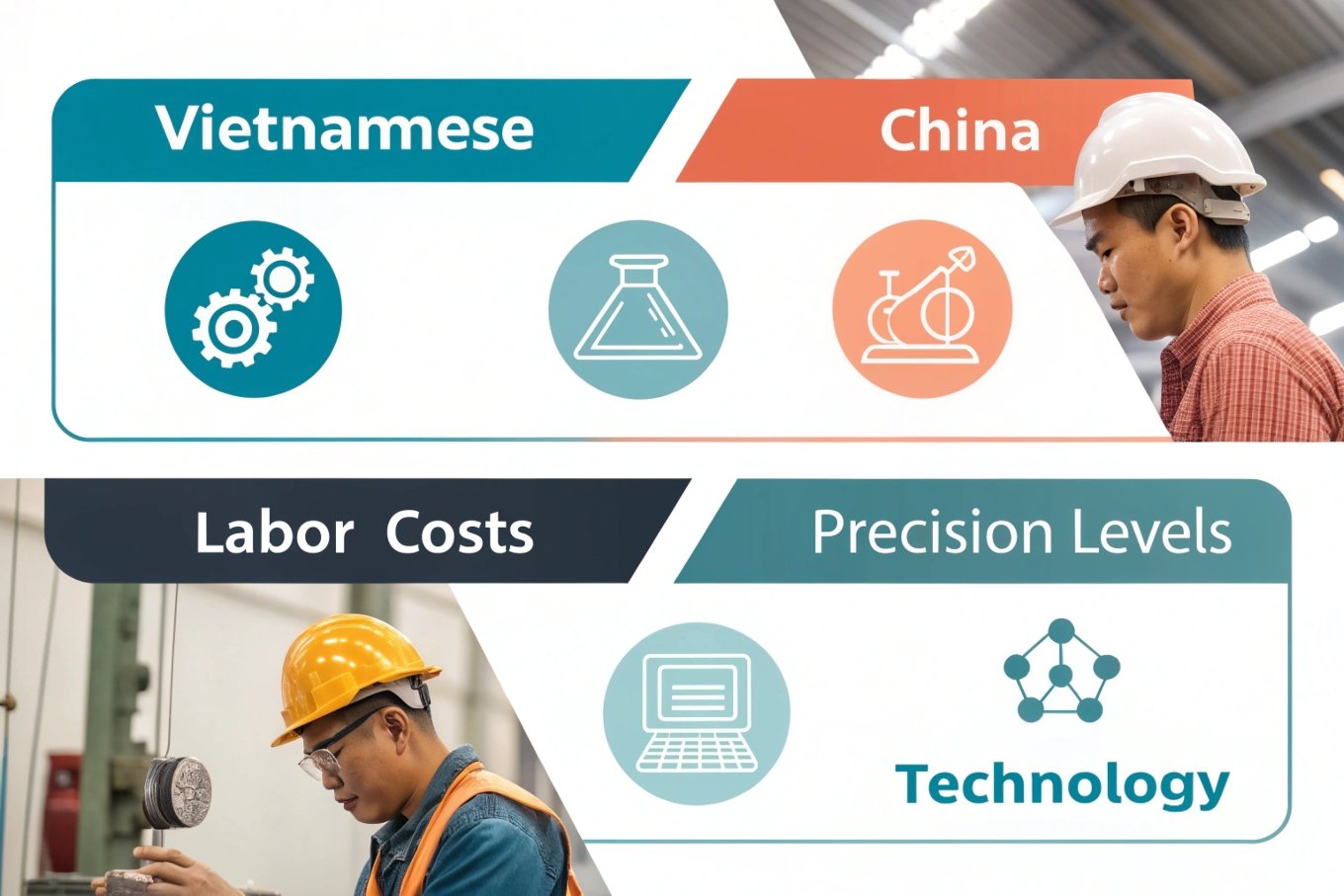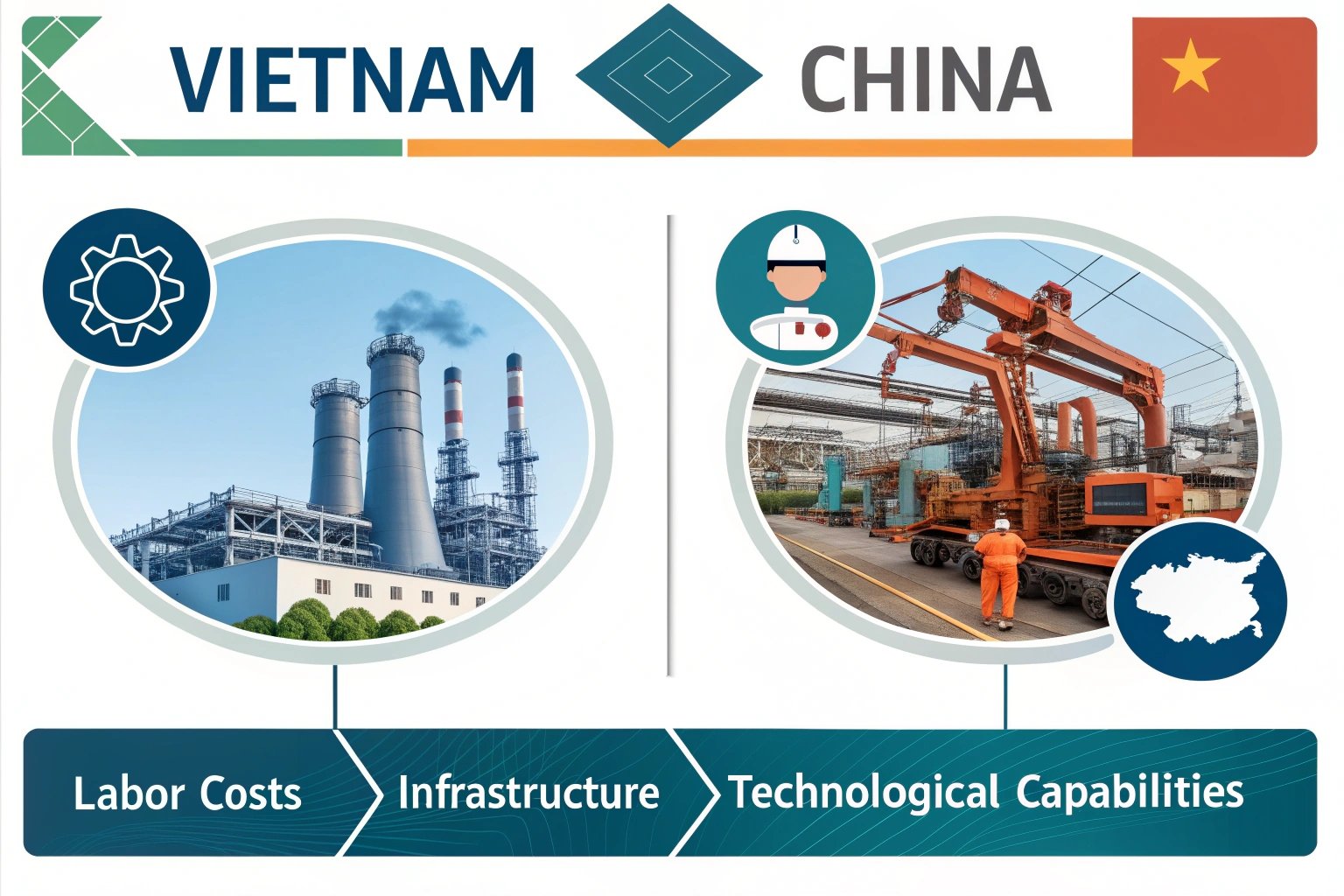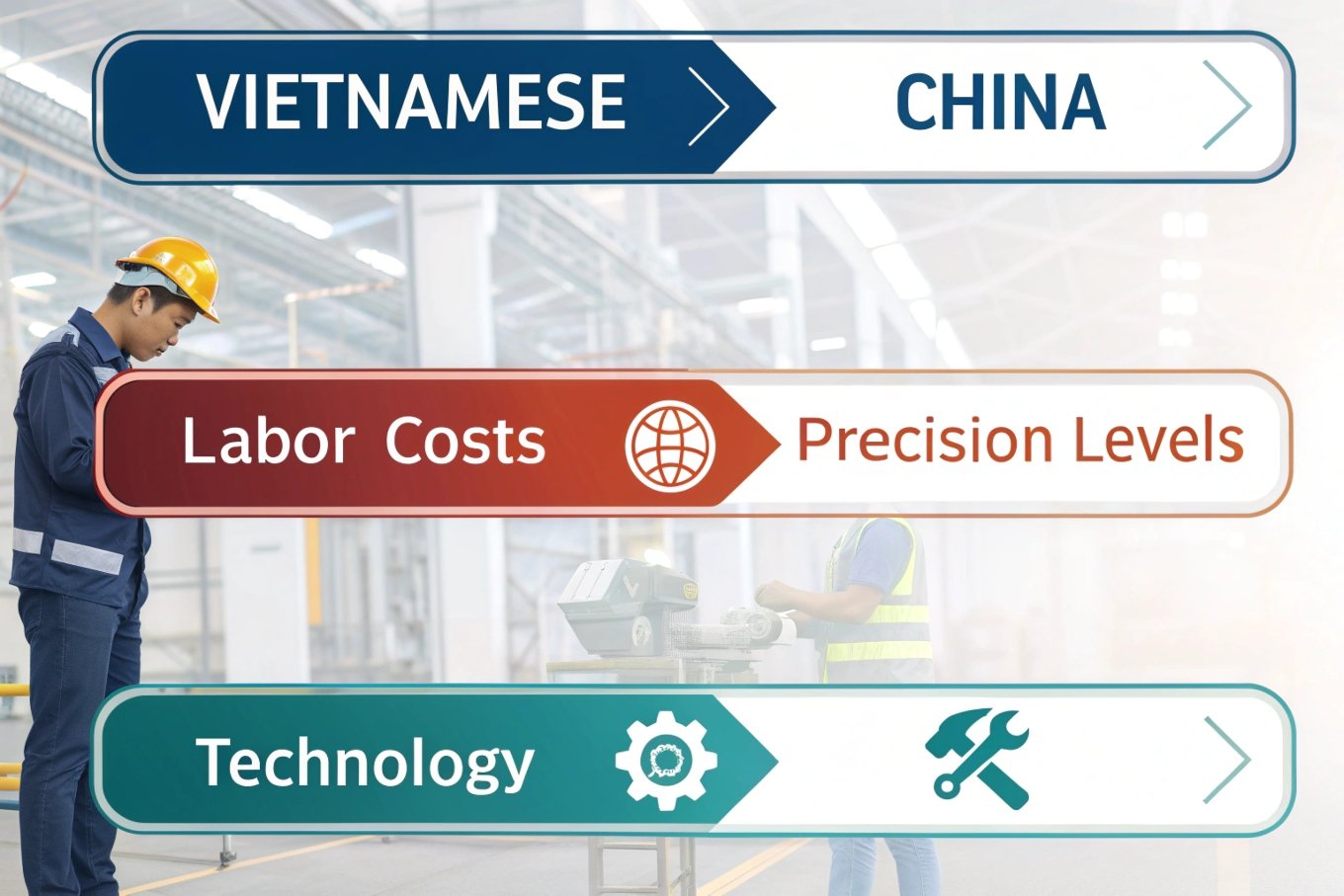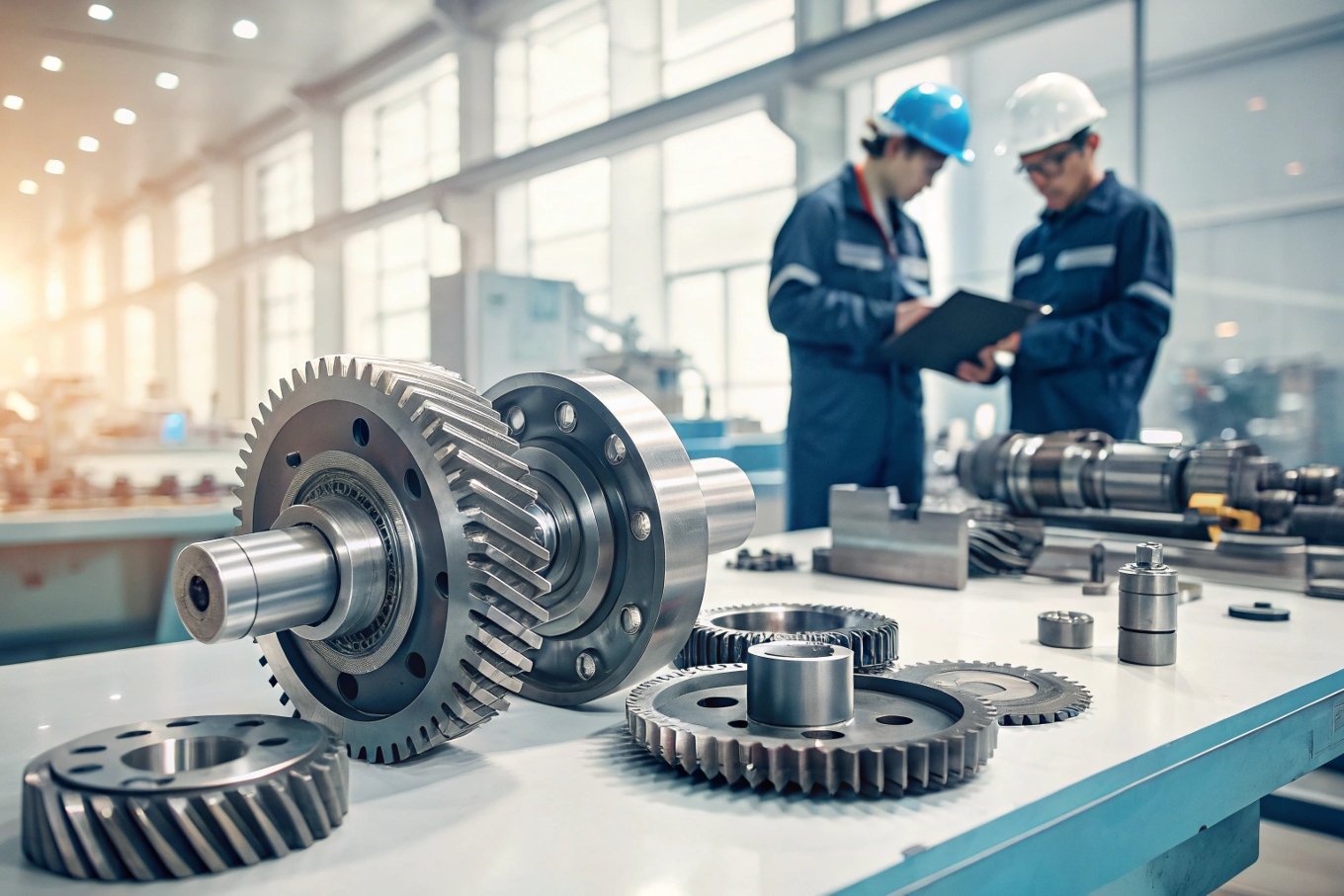
The comparison between Vietnamese and Chinese manufacturers has been a hot topic in recent years. Both countries offer unique advantages, but how do they truly differ when it comes to precision, quality, and control in mechanical parts manufacturing?
The main difference between the two lies in labor costs, supply chain infrastructure, and technological capabilities. While Vietnam offers lower costs, China maintains a more advanced and robust manufacturing ecosystem.
Understanding these differences is essential for businesses looking to make the most informed sourcing decisions. Let’s take a closer look at how each country performs in these critical areas.
What is the difference between made in China and Vietnam?
There are several factors that set apart products made in China from those made in Vietnam. From labor costs to supply chains and technological advancements, each country has its own strengths and challenges.
China’s manufacturing sector is more mature, with highly advanced technology and a more established supply chain. On the other hand, Vietnam is an emerging player, offering lower costs but with certain limitations in infrastructure and production capabilities.

Labor Costs and Productivity
Labor costs in Vietnam are significantly lower than in China, even compared to China’s costs from over a decade ago. This makes Vietnam an attractive destination for businesses focused on reducing production costs, especially in industries like apparel, furniture, and basic mechanical components.
However, while the cost advantage is clear, there are trade-offs. The Vietnamese workforce, while growing in skill, generally lacks the experience that Chinese workers have, particularly in specialized and high-precision manufacturing. This difference can sometimes affect the consistency and precision of mechanical parts, especially those requiring advanced technology.
Supply Chain and Infrastructure
China’s supply chain1 is one of the most advanced in the world, with a robust network for sourcing materials, components, and finished goods. In contrast, Vietnam’s supply chain is still developing, and many Vietnamese manufacturers rely on imports from China for raw materials like steel, fasteners, and other components. This reliance can lead to longer lead times and higher costs, making the sourcing process from Vietnam slower than from China.
That said, Vietnam’s supply chain is improving rapidly. While it may not yet match China’s in terms of scale, ongoing investments in infrastructure are helping to close the gap. For businesses, this might mean a hybrid approach—using Chinese suppliers for materials and Vietnamese manufacturers for labor-intensive processes—could be the best strategy.
Technological Advancements
China leads the way when it comes to technology and precision manufacturing. Chinese factories are equipped with state-of-the-art machinery and highly skilled workers, making it an ideal choice for industries that require advanced, high-precision components.
Vietnam, by comparison, is still catching up, particularly in sectors that demand cutting-edge technology. However, there has been a significant effort by Vietnamese manufacturers to modernize their equipment and improve their skill sets. While they are making progress, they still lag behind China in terms of the technology available in factories and the experience of workers in utilizing that technology.
In conclusion, while China excels in high-volume, high-precision manufacturing, Vietnam is still emerging as a viable alternative for many cost-sensitive industries.
Can Vietnam replace China as a manufacturing hub?
With increasing tariffs and the ongoing trade war between the US and China, many businesses are looking for alternatives. Can Vietnam step in to replace China as the primary manufacturing hub?
While Vietnam offers significant advantages in labor costs, it is unlikely to fully replace China in the near future. Vietnam is a great option for specific industries, particularly those focused on reducing costs, but China’s advanced infrastructure and capabilities make it difficult to fully substitute.

Advantages of Sourcing from Vietnam
One of the key benefits of sourcing from Vietnam is its low labor costs2. In recent years, the country has become a popular alternative for businesses seeking to avoid high tariffs and rising wages in China. This makes it especially attractive for industries like textiles, basic electronics, and some mechanical components, where labor costs are a significant portion of production expenses.
Vietnam’s government has made efforts to attract foreign investment and develop its industrial capabilities, which has led to improvements in manufacturing infrastructure. While not as advanced as China’s, Vietnam’s supply chain3 is growing and becoming more efficient. In industries where labor-intensive work is required, Vietnam has proven to be an excellent alternative.
Challenges of Sourcing from Vietnam
Despite its advantages, there are some challenges to sourcing from Vietnam. The country’s supply chain is still developing, and many manufacturers rely on imports from China for raw materials and components. This can lead to delays and increased costs, especially in industries that require high-quality or specialized components.
Another challenge is the experience of the workforce. Although Vietnam is making strides in education and training, it doesn’t yet have the same level of expertise as China’s workforce, particularly in high-tech and precision manufacturing sectors. This can affect product quality and consistency, particularly for more complex mechanical parts.
Although Vietnam is unlikely to completely replace China as a manufacturing hub, it offers a valuable alternative for companies that are looking to diversify their supply chains, especially in industries focused on labor-intensive work.
Is made in Vietnam high-quality?
There’s a common misconception that products made in Vietnam are of lower quality compared to those made in China. But is this really the case, especially for mechanical parts?
Made in Vietnam doesn’t mean lower quality. Many manufacturers in Vietnam are now producing high-quality mechanical parts4 that meet international standards, especially in industries like electronics and automotive.

Quality Control in Vietnam
Vietnam’s manufacturing sector has made significant strides in quality control in recent years. Many factories are now ISO 9001 certified, which means they meet internationally recognized quality management standards. Moreover, several manufacturers in Vietnam are investing in modern equipment and employee training to improve product quality.
However, it’s important to note that, like any manufacturing location, the quality of products can vary depending on the factory and the industry. For basic mechanical parts, Vietnam can produce high-quality products. But for more complex and precise parts, the experience of the workforce and the capabilities of the factory should be carefully evaluated.
Industry-Specific Differences
The quality of mechanical parts produced in Vietnam also varies by industry. For example, Vietnam excels in the production of basic components for the furniture and electronics industries. However, when it comes to high-precision mechanical parts, many companies still turn to China for more complex requirements.
That being said, there are numerous Vietnamese manufacturers capable of producing high-quality, customized mechanical parts, particularly as the country’s industrial capabilities continue to grow. As the manufacturing sector matures and investment in technology and training increases, Vietnam’s quality will continue to improve.
Comparison of Key Manufacturing Factors in Vietnam and China
| Factor | Vietnam | China |
|---|---|---|
| Labor Costs | Lower, but rising due to demand for skilled workers | Higher, but large-scale production benefits reduce per-unit costs |
| Supply Chain | Developing, heavily dependent on China for materials | Well-established, self-sufficient in raw materials and components |
| Technology and Precision | Catching up, with modern management and equipment | Advanced, with extensive experience and equipment in precision manufacturing |
| Lead Time | Longer due to less developed infrastructure | Shorter, with more established logistics and supply chain systems |
Quality Control Standards and Certifications
| Quality Certification | Vietnam Manufacturers | China Manufacturers |
|---|---|---|
| ISO 9001 | Gaining traction, many factories certified | Widely adopted across industries |
| ISO 14001 (Environmental) | Increasing adoption | Common in large-scale operations |
| IATF 16949 (Automotive) | Gaining ground in automotive parts | Strong presence in automotive manufacturing |
Comparison of Commonly Sourced Mechanical Parts
| Part Type | Manufactured in Vietnam | Manufactured in China |
|---|---|---|
| Basic mechanical parts | Common, especially in labor-intensive industries | Very common, highly advanced capabilities |
| Automotive parts | Gaining ground, but limited in high precision | Extensive, with a focus on high-precision components |
| Electronics parts | Becoming more common, especially in consumer electronics | Widely produced, with a strong focus on mass production |
| Furniture and household items | Common, with skilled craftsmanship | Often produced at a larger scale for international demand |
Conclusion
To summarize, while Vietnam offers a competitive alternative to China, especially in terms of labor costs, it cannot fully replace China’s infrastructure and technological capabilities. However, for certain industries, especially those requiring lower production costs or labor-intensive processes, Vietnam is a viable option. The future likely involves a mix of both countries, with each complementing the other in different aspects of manufacturing.
Exploring the intricacies of China’s supply chain can provide insights into its efficiency and how it supports global manufacturing. ↩
Exploring this link will provide insights into how Vietnam’s low labor costs can benefit your manufacturing strategy, offering a competitive edge. ↩
This resource will help you understand the current state and future potential of Vietnam’s supply chain, crucial for making informed sourcing decisions. ↩
Discover how Vietnam is meeting international standards in mechanical parts production, challenging the misconception of lower quality. ↩

